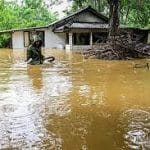ISLAMABAD, Jun 22 (APP):The recent pre-Monsoon rain spells that lashed various parts of the country and dropped mercury drastically after scorching heatwaves would help improve aquatic life of Rawal Dam as the reservoir is filled near to its maximum capacity.
Rawal lake, which supplies drinking water to the city of Rawalpindi, is home of various fish species, turtles, and aquaculture that created a unique ecosystem threatened by man-made pollution in the reservoir, said an official of the Fisheries Department of the Islamabad Capital Territory (ICT).
The water in the Rawal Dam was collected through the rainwater coming from the Margalla hills catchments which ultimately improves the growth of aquatic life. “The rainwater along with dust and sludge brings various nutrients, micro plant species and organisms that help the aqua culture in the reservoir improve the quality of water which in turn helps synthesis of healthy habitat for the marine life”, the Fisheries Department official told APP.
He said the opening of spillways of the Dam was also another challenge that poses risk to the fish that faced damage during the process. “The dam authorities are advised to avoid abrupt aperture of spillways that cause big fish to fall down rendering loss of precious species”.
The people used to catch the falling out fish by physically venturing into running water of the spillways which directly jeopardized those individuals’ lives. However, in order to tackle this nuisance, the fisheries department has installed nets at a distance of 200-300 feet from the spillways to avoid drifting out of fish.
The Executive Engineer (XEN) of Rawal Dam Amir Mumtaz told APP that the total storage capacity of the reservoir was 1752 which was at the moment filled up till 1745.5 feet with an extra cushion of 7.5 feet storage capacity available. He said the rainwater during the monsoon downpour used to fill the reservoir to its maximum capacity whereas the rains have stopped and this water would start receding in the coming days.
When contacted Deputy Director Fisheries Rawalpindi, Mir Latif, in his expert opinion, said rains used to bring nutrients and soil enriched with essential minerals that prove to be supportive for aquatic growth especially fish which are under threat during drought season. He said sudden water rise in the reservoir causes fish mortality with immediate water bed turn over.
Latif said, “The rain water accumulated in the dam turns greenish due to micro-plants brought with the deluge from the catchments gives healthy habitat for the growth of fish”.
He said the water settles in the dam within 3-4 weeks at the same time as the aquatic life develops, however, if the thunderstorm and heavy rainfall persists then it could disturb water species synthesis. “It develops instantly in favourable conditions”, he added.
While commenting on the water pollution jeopardizing the water life, he said the direct flow of household or sewage waste of Lakhwal village; Bani Gala residential area and Murree Brewery were the major polluters.
He said the small scale drainage of the waste is not harmful while the large scale can prove to be fatal. A water treatment plant was proposed to be installed near the residential areas for purification of the contaminated water which was dropped due to financial issues, he said.
Later, soaking pits were advised to be built by the area residents besides their houses which were constructed in the beginning by the residents of Bani Gala, he said.
He said the new Bani Gala residents were not developing the pits and were dumping their sewage waste in the dam which was causing harmful impacts on the water table and water species.
According to the Met office, the federal capital received a rainfall of 69 millimeters which was one of the highest recorded in past 24 hours in various parts of the country.
Follow the PNI Facebook page for the latest news and updates.







